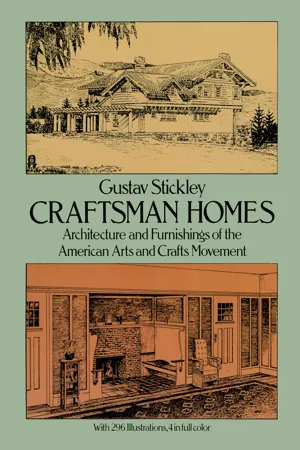
This is a test
- 224 pages
- English
- ePUB (mobile friendly)
- Available on iOS & Android
eBook - ePub
Craftsman Homes
Book details
Book preview
Table of contents
Citations
About This Book
296 architectural drawings, floor plans, and photographs illustrate 40 different kinds of "Mission-style" homes from The Craftsman (1901-16), voice of American style of simplicity and organic harmony. Thorough coverage of Craftsman idea in text and picture, now collector's item.
Frequently asked questions
At the moment all of our mobile-responsive ePub books are available to download via the app. Most of our PDFs are also available to download and we're working on making the final remaining ones downloadable now. Learn more here.
Both plans give you full access to the library and all of Perlego’s features. The only differences are the price and subscription period: With the annual plan you’ll save around 30% compared to 12 months on the monthly plan.
We are an online textbook subscription service, where you can get access to an entire online library for less than the price of a single book per month. With over 1 million books across 1000+ topics, we’ve got you covered! Learn more here.
Look out for the read-aloud symbol on your next book to see if you can listen to it. The read-aloud tool reads text aloud for you, highlighting the text as it is being read. You can pause it, speed it up and slow it down. Learn more here.
Yes, you can access Craftsman Homes by Gustav Stickley in PDF and/or ePUB format, as well as other popular books in Architecture & History of Architecture. We have over one million books available in our catalogue for you to explore.
Information
Topic
ArchitectureSubtopic
History of ArchitectureCABINET WORK FOR HOME WORKERS AND STUDENTS WHO WISH TO LEARN THE FUNDAMENTAL PRINCIPLES OF CONSTRUCTION
IN the brief sketch we have already given of furniture making in this country we made the statement that one of the chief elements of interest in Craftsman furniture is the fact that its construction is so simple and direct and so clearly revealed that any one possessing even a rudimentary knowledge of tools and of drawing and some natural skill of hand could easily make for himself many pieces of furniture in this style. Believing this thoroughly, and also realizing fully the interest that cabinetwork holds for most people and the means it affords of developing the constructive and creative faculties, we have given in THE CRAFTSMAN a number of designs solely for the benefit of home workers. For a year or two we published, in connection with these designs, full working drawings and also mill bills for the necessary lumber; but we were forced to abandon that on account of lack of space and to give only the drawings showing the finished pieces, for which the working drawings and mill bills were easily obtainable upon application.
We illustrate here a number of these designs, most of which are for pieces that are fairly easy to make and that have a definite use as household furnishings. While the designs of course show the exact models of the pieces they represent, we intend them to have also a suggestive value and to stimulate thought and experiment along the lines of designing and making plain substantial furniture. It has been proven beyond question that the most powerful stimulus to well-defined constructive thought is found in the direction of the mind to some form of creative work. Therefore if a man or a boy has any aptitude e along these lines, it is a foregone conclusion that he will not have made many pieces after given models before he begins to think for himself and to make or modify designs to meet his own demands and to afford an opportunity for working out his own problems. Furthermore, as his experience grows, he will naturally discover new ways of doing things that may be better for him to follow than any of the stereotyped rules. We approve thoroughly of the freedom of spirit that leads to such experimenting, for, although we originated the Craftsman furniture, it is just such interest and work on the part of other people that will ultimately develop it into a national style. One warning, however, we would like to give to all amateur workers: that is, that one’s own whims must no more be followed than the whims of other people. We will find plenty of interest and occupation in making things that are actually needed and plenty of exercise for all our creative power in designing them to fulfil as adequately as possible the purpose for which they are intended. So long as this is done there is no danger of the work degenerating into a fad; instead, it is likely not only to give much pleasure and profit to individuals, but to grow until the whole nation once more reaps the benefit that comes from the intelligent exercise of the creative powers in some interesting form of handicraft.
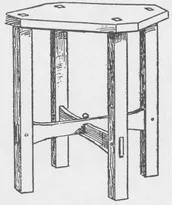
FIGURE ONE.—SQUARE TABOURET.

FIGURE TWO.—A ROUND TABOURET.
Every one knows the relief to brain workers and to professional men that is found in this kind of work. It not only affords a wholesome change of occupation but brings into play a different set of faculties and so proves both restful and stimulating. A professional or business man who can find relief from his regular work in some such pursuit, which he takes up as a recreation, does better work in his own vocation because he is a healthier and better balanced man and his interest in his home grows more vivid and personal with every article of furniture that he makes with his own hands and according to his own ideas.
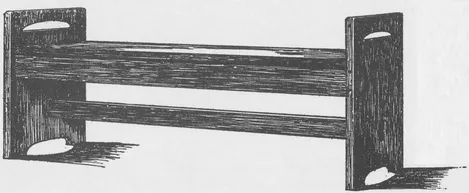
FIGURE THREE.—HALL BENCH WITH CHEST.
As for the means of education afforded by this kind of work, we have no better proof than is shown by the widespread belief in the efficacy of manual training in our public schools, although to a practical craftsman there would seem to be plenty of room for improvement, both as to methods of teaching and the quality of workmanship that is required from the students. Where manual training is taken up purely on account of the mental development it affords, there is a tendency to make it entirely academic. The teachers for the most part rely almost wholly upon theory and have very little practical knowledge of the thing they teach. The result is that a boy is encouraged to “express his own individuality” in designing and making the thing that appeals to him instead of being taught sound principles of design and construction and so guided by a competent worker that all his own work is based upon these principles and is thoroughly done. If the work is merely regarded as play, the theoretical attitude toward the expression of individuality is all right; but if it is regarded as a preparation for the serious business of later life, the result shows that it unfits the student for real work in just such measure as he shows an aptitude for play work.

FIGURE FOUR.—CHILD’S OPEN BOOKCASE.
The introduction of the Craftsman style has practically revolutionized manual training in our public schools, because it has placed at the disposal of the teachers designs of such simplicity and clearness of construction that the work of teaching has been made much easier and the field of manual training has been greatly broadened. Before the introduction of Craftsman furniture, manual training in the schools rested chiefly upon sloyd, which was confined to the making of small articles entirely for the sake of the mental development afforded by the intelligent use of the hands. Now, however, the students of manual training are learning to make furniture after such models as we show here and the very necessary element of usefulness is added to the things they make. The only difficulty is that the craft itself is not well enough understood by the teachers to be imparted to the students in such a way that they derive any permanent benefit from it. The teaching is, as we have said, largely theoretical and the object of the whole training is mental development along general lines rather than the moral development that comes from learning to do useful work thoroughly and well. As cabinetwork is handled in the manual training departments of the schools, it is distinctly a side issue, and exhibitions of the work to which public attention is frequently invited show ambitious pieces of furniture that are wrongly proportioned, badly put together and finished in a slovenly way, thus producing exactly the opposite effect upon the pupil from what is intended. If the State or municipal authorities would see to it that manual training in the form of wood-working of all kinds, and especially the making of furniture, were placed under the charge of thoroughly skilled craftsmen who understood and were able to teach all the principles of construction, the moral and educational effect of such work would be almost incalculable.
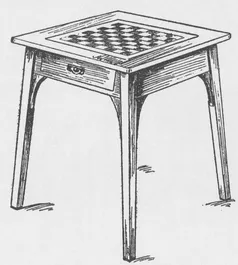
FIGURE FIVE.—CHESS OR CHECKER TABLE.
In order to make the training of any real value, it is absolutely necessary that the student begin simultaneously with mechanical drawing and the application of its principles to his work as he goes along. If he began with simple models to which could be applied the elementary lessons in mechanical drawing, the laying out of plans, the reading of detail drawings and the like, and would also afford a chance to demonstrate lessons in the use of the square, the level, the saw and the plane;—a good foundation would be laid not only for the understanding of right principles of construction but for the accurate use of tools. A boy trained in this way would be able in future years to put his knowledge to almost any use that was needed. Instead of this the students endeavor to make something that is interesting and that shows well at home or in an exhibition. In fact, the situation now is very much as it would be if a student of music were to take two or three lessons in the rudiments and then endeavor to play a more or less elaborate composition. There is no question as to the benefit that boys, and girls too, derive from being taught to work with their hands; but it is better not to teach them at all than to give them the wrong teaching. No one expects a schoolboy or an amateur worker of any age to make elaborate furniture that would equal similar pieces made by a trained cabinet-maker. But if the student be taught to make small and simple things and to make each one so that it would pass muster anywhere, he learns from the start the fundamental principles of design and proportion and so comes naturally to understand what is meant by thorough workmanship.
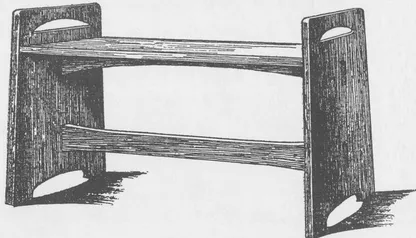
FIGURE SIX.—PIANO BENCH, STRONGLY MADE WITH SOLID ENDS.
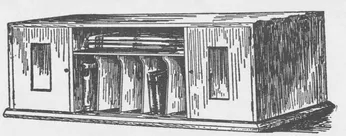
FIGURE SEVEN.—PORTABLE CABINET FOR WRITING TABLE.
There is no objection to any worker, however inexperienced, attempting to express his own individuality, but the natural thing would be for him to express it in more or less primitive forms of construction that are, so far as they go, correct, instead of attempting something that, when it is finished, is all wrong because the student has not understood what he was about. Unquestionably there are certain principles and rules as to design, proportion and form that are as fundamental in their nature as are the tables of addition, subtraction, division and multiplication, with relation to mathematics, or as the alphabet is as a basis to literature, but they are not yet formulated for general use. The trained worker learns these things by experience and comes to have a sort of sixth sense with regard to their application, but this takes strong direct thinking, keen observation and the power of initiative that is possessed only by the very exceptional and highly skilled workman.
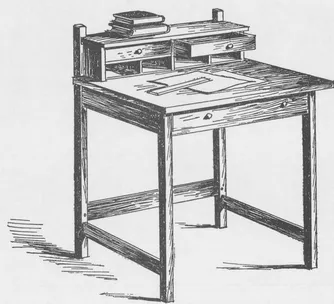
FIGURE EIGHT.—CHILD’S WRITING DESK.
Nevertheless it surely is as easy to begin work in the right way as in the wrong way. It would be better if all our teaching of manual training were based upon some text book carefully compiled by a master workman and kept within certain well defined limits. After the student had thoroughly learned all that lay within these limits and was grounded in the principles of design and construction as carefully as he would be grounded in mathematics or classical literature, he might safely be trusted to produce something that would express his own individuality, for then, if ever, he would have developed an individuality that was worth while. And this principle applies as well to amateur workers of all kinds as it does to the students in the public schools, for it is the basis of all work that is worthy to endure.
One great advantage of taking up cabinetmaking at home as well as in the schools, is that it could be made not only a means of amusement or mental development to the individual, but could be expanded into a home or neighborhood handicraft that might be carried on in connection with small farming, upon a basis that would insure a reasonable financial success. Handicrafts, as practiced by individual arts and crafts workers in the studio, do not afford a sufficient living to craft workers as a class, but that is largely because these very principles of sound construction and thorough workmanship are not always observed or even comprehended, so that it is difficult for the individual worker to produce anything that has a definite and permanent commercial value. This kind of furniture, on the contrary, has a very well defined and thoroughly established commercial value, as our own experience has proven; and yet it is so simple in design and construction that it can be made at home or on the farm during the idle months of winter or by a group of workers in a village,—in fact under almost any conditions where it would seem advantageous to do such work, especially under the guidance of a competent cabinetmaker.
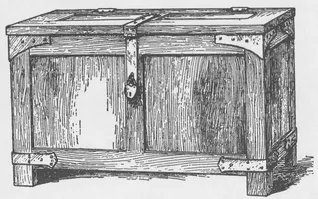
FIGURE NINE.—BRIDE’S CHEST.
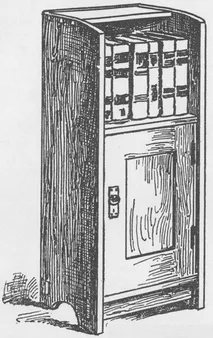
FIGURE TEN.—BOOK CABINET.
Whether regarded as one of the forms of a profitable ...
Table of contents
- Title Page
- Copyright Page
- Epigraph
- Table of Contents
- Epigraph
- “THE SIMPLIFICATION OF LIFE:” A CHAPTER FROM EDWARD CARPENTER’S BOOK CALLED “ENGLAND’S IDEAL”
- “THE ART OF BUILDING A HOME”: BY BARRY PARKER AND RAYMOND UNWIN
- A CRAFTSMAN HOUSE FOUNDED ON THE CALIFORNIA MISSION STYLE
- AN OLD-FASHIONED HOUSE WITH THE DINING ROOM AND KITCHEN IN ONE
- A SMALL COTTAGE THAT IS COMFORTABLE, ATTRACTIVE AND INEXPENSIVE
- A PLAIN HOUSE THAT WILL LAST FOR GENERATIONS AND NEED BUT FEW REPAIRS
- A COTTAGE OF CEMENT OR STONE THAT IS CONVENIENTLY ARRANGED FOR A SMALL FAMILY
- SUBURBAN HOUSE DESIGNED FOR A LOT HAVING WIDE FRONTAGE BUT LITTLE DEPTH
- A VERY SIMPLE AND INEXPENSIVE COTTAGE BUILT OF BATTENED BOARDS
- A CEMENT HOUSE THAT SHOWS THE DECORATIVE USE OF CONCRETE AS A FRAMEWORK
- CEMENT HOUSE SHOWING LAVISH USE OF HALF-TIMBER AS A DECORATION
- CEMENT HOUSE SHOWING CRAFTSMAN IDEA OF HALF-TIMBER CONSTRUCTION
- A COMFORTABLE AND CONVENIENT HOUSE FOR THE SUBURBS OR THE COUNTRY
- A CRAFTSMAN CITY HOUSE DESIGNED TO ACCOMMODATE TWO FAMILIES
- A CRAFTSMAN FARM HOUSE THAT IS COMFORTABLE, HOMELIKE AND BEAUTIFUL
- HOUSE WITH COURT, PERGOLAS, OUTDOOR LIVING ROOMS AND SLEEPING BALCONIES
- THE CRAFTSMAN’S HOUSE: A PRACTICAL APPLICATION OF OUR THEORIES OF HOME BUILDING
- A SMALL SHINGLED HOUSE THAT SHOWS MANY INTERESTING STRUCTURAL FEATURES
- A ROOMY, INVITING FARMHOUSE, DESIGNED FOR PLEASANT HOME LIFE IN THE COUNTRY
- A SIMPLE, STRAIGHTFORWARD DESIGN FROM WHICH MANY HOMES HAVE BEEN BUILT
- A CRAFTSMAN HOUSE IN WHICH TOWER CONSTRUCTION HAS BEEN EFFECTIVELY USED
- A CONCRETE COTTAGE DESIGNED IN THE FORM OF A GREEK CROSS TO ADMIT MORE LIGHT
- A BUNGALOW OF IRREGULAR FORM AND UNUSUALLY INTERESTING CONSTRUCTION
- A ROOMY, HOMELIKE FARMHOUSE FOR LOVERS OF PLAIN AND WHOLESOME COUNTRY LIFE
- A PLASTER HOUSE UPON WHICH WOOD HAS BEEN LIBERALLY USED
- A FARMHOUSE DESIGNED WITH A LONG, UNBROKEN ROOF LINE AT THE BACK
- TWO INEXPENSIVE BUT CHARMING COTTAGES FOR WOMEN WHO WANT THEIR OWN HOMES
- A LOG HOUSE THAT WILL SERVE EITHER AS A SUMMER CAMP OR A COUNTRY HOME
- A PLEASANT AND HOMELIKE COTTAGE DESIGNED FOR A SMALL FAMILY
- A COUNTRY CLUBHOUSE THAT IS BUILT LIKE A LOG CABIN
- A PLAIN LITTLE CABIN THAT WOULD MAKE A GOOD SUMMER HOME IN THE WOODS
- A BUNGALOW BUILT AROUND A COURTYARD FACING THE WATER
- A RUSTIC CABIN THAT IS MEANT FOR A WEEKEND COTTAGE OR A VACATION HOME
- A BUNGALOW DESIGNED FOR A MOUNTAIN CAMP OR SUMMER HOME
- A CONVENIENT BUNGALOW WITH SEPARATE KITCHEN AND OPEN AIR DINING ROOM
- A COTTAGE PLANNED WITH A SPECIAL IDEA TO ECONOMICAL HEATING
- A COTTAGE THAT COMES WITHIN THE LIMITS OF VERY MODERATE MEANS
- A COUNTRY HOUSE THAT WAS ORIGINALLY PLANNED FOR A MOUNTAIN CAMP
- PORCHES, PERGOLAS AND TERRACES: THE CHARM OF LIVING OUT OF DOORS
- THE EFFECTIVE USE OF COBBLESTONES AS A LINK BETWEEN HOUSE AND LANDSCAPE
- BEAUTIFUL GARDEN GATES : THE CHARM THAT IS ALWAYS FOUND IN AN INTERESTING APPROACH TO AN ENCLOSURE
- THE NATURAL GARDEN: SOME THINGS THAT CAN BE DONE WHEN NATURE IS FOLLOWED INSTEAD OF THWARTED
- WHAT MAY BE DONE WITH WATER AND ROCKS IN A LITTLE GARDEN
- HALLS AND STAIRWAYS: THEIR IMPORTANCE IN THE GENERAL SCHEME OF A CRAFTSMAN HOUSE
- THE LIVING ROOM: ITS MANY USES AND THE POSSIBILITIES IT HAS FOR COMFORT AND BEAUTY
- THE DINING ROOM AS A CENTER OF HOSPITALITY AND GOOD CHEER
- A CONVENIENT AND WELL-EQUIPPED KITCHEN THAT SIMPLIFIES THE HOUSEWORK
- THE TREATMENT OF WALL SPACES SO THAT A ROOM IS IN ITSELF COMPLETE AND SATISFYING
- FLOORS THAT COMPLETE THE DECORATIVE SCHEME OF A ROOM
- AN OUTLINE OF FURNITURE-MAKING IN THIS COUNTRY: SHOWING THE PLACE OF CRAFTSMAN FURNITURE IN THE EVOLUTION OF AN AMERICAN STYLE
- WILLOW CHAIRS AND SETTLES WHICH HARMONIZE WITH THE MORE SEVERE AND MASSIVE FURNITURE MADE OF OAK
- CRAFTSMAN METAL WORK : DESIGNED AND MADE ACCORDING TO THE SAME PRINCIPLES THAT RULE THE FURNITURE
- THE KIND OF FABRICS AND NEEDLEWORK THAT HARMONIZE WITH AND COMPLETE THE CRAFTSMAN DECORATIVE SCHEME
- CABINET WORK FOR HOME WORKERS AND STUDENTS WHO WISH TO LEARN THE FUNDAMENTAL PRINCIPLES OF CONSTRUCTION
- OUR NATIVE WOODS AND THE CRAFTSMAN METHOD OF FINISHING THEM
- THE CRAFTSMAN IDEA OF THE KIND OF HOME ENVIRONMENT THAT WOULD RESULT FROM MORE NATURAL STANDARDS OF LIFE AND WORK